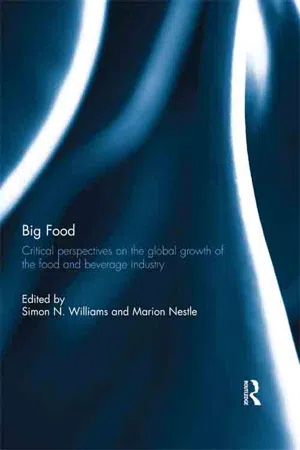
Big Food
Critical perspectives on the global growth of the food and beverage industry
- 160 pages
- English
- ePUB (mobile friendly)
- Available on iOS & Android
Big Food
Critical perspectives on the global growth of the food and beverage industry
About This Book
Obesity is a global public health problem of crucial importance. Obesity rates remain high in high-income countries and are rapidly increasing in low- and middle- income countries. Concurrently, the global consumption of unhealthy products, such as soft drinks and processed foods, continues to rise. The ongoing expansion of multinational food and beverage companies, or 'Big Food', is a key factor behind these trends.
This collection provides critical insight into the global expansion of 'Big Food', including its incursion into low-and-middle income countries. It examines the changing dynamics of the global food supply, and discusses how low-income countries can alter the 'Big Food'-diet from the bottom-up. It examines a number of issues related to 'Big Food' marketing strategies, including the way in which they advertise to youths and the rural poor. These issues are discussed in terms of their public health implications, and their relation to public health activities, for example 'soda taxes', and the promotion of nutritionally-healthier products. This book was originally published as a special issue of Critical Public Health.
Frequently asked questions
Information
The transitional dynamics of caloric ecosystems: changes in the food supply around the world
Table of contents
- Cover
- Half Title
- Title
- Copyright
- Contents
- Citation Information
- Introduction – ‘Big Food’: taking a critical perspective on a global public health problem
- 1. The transitional dynamics of caloric ecosystems: changes in the food supply around the world
- 2. Big Food without big diets? Food regimes and Kenyan diets
- 3. Density of outdoor food and beverage advertising around schools in Ulaanbaatar (Mongolia) and Manila (The Philippines) and implications for policy
- 4. Snack food advertising in stores around public schools in Guatemala
- 5. The incursion of ‘Big Food’ in middle-income countries: a qualitative documentary case study analysis of the soft drinks industry in China and India
- 6. Comparison of food industry policies and commitments on marketing to children and product (re)formulation in Australia, New Zealand and Fiji
- 7. Encouraging big food to do the right thing for children’s health: a case study on using research to improve marketing of sugary cereals
- 8. Big Soda’s long shadow: news coverage of local proposals to tax sugar-sweetened beverages in Richmond, El Monte and Telluride
- 9. ‘Big Food’ and ‘gamified’ products: promotion, packaging, and the promise of fun
- 10. Food as pharma: marketing nutraceuticals to India’s rural poor
- Index